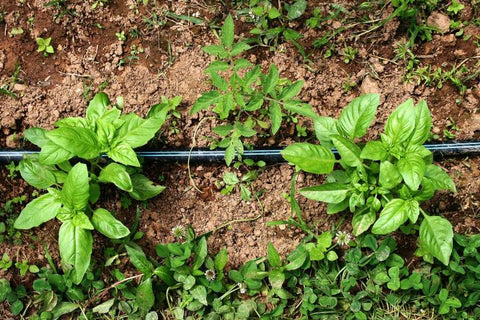Ferns are among the oldest living plants, having existed for millions of years, and their delicate fronds have a timeless appeal. They add a lush, verdant touch to any space, making them a favorite for plant enthusiasts. Beyond their beauty, ferns are also excellent natural air purifiers, removing toxins like formaldehyde and xylene from indoor air. Their feathery, arching fronds can transform any room into a tranquil, forest-like retreat. Plus, with the right care, they thrive in low to medium light conditions, making them perfect for homes and apartments with indirect sunlight.The following content also has some reference value for raised garden beds.
Understanding Fern Care: The Basics to Know Before You Grow
Ferns are a classic addition to any home, known for their lush, feathery foliage that adds a touch of greenery to any space. However, before bringing a fern into your home, it's essential to understand their unique needs. Unlike more common houseplants such as succulents or pothos, which can tolerate drier conditions, ferns have specific requirements that mimic their natural habitats—typically shaded, humid forest floors. Here are some key things to know to help your fern thrive:
- Humidity is Key
Ferns naturally grow in environments with high humidity, so they prefer similar conditions in your home. To create this, consider placing a humidifier nearby, misting the leaves regularly, or setting the pot on a tray filled with pebbles and water. Grouping your fern with other plants can also help create a more humid microclimate, as the combined transpiration from multiple plants increases the moisture in the air.
- Consistent Moisture
Unlike drought-tolerant plants, ferns need consistently moist soil. This doesn't mean waterlogging them, as that can lead to root rot, but it does mean maintaining even moisture. When the top inch of soil feels a little dry, water your fern. During hotter months, you may need to water more frequently, while in cooler, dormant periods, you can reduce the watering schedule.
- Well-Draining Soil
Ferns prefer soil that retains moisture without becoming waterlogged. A good potting mix for ferns typically includes components like peat moss, perlite, and pine bark, which provide a balance of moisture retention and drainage. Consider using a pot with drainage holes to prevent excess water from sitting at the bottom, which can cause root issues.
- Indirect Light
Most ferns thrive in bright, indirect light. Direct sunlight can scorch their delicate fronds, so it's best to place them in a spot where they receive filtered light, such as near a north or east-facing window. If your fern's fronds start to turn yellow or brown, it may be getting too much direct light and should be moved to a shadier spot.
- Fertilizing Needs
While ferns are not heavy feeders, they benefit from occasional fertilizing during their growing season (spring and summer). To supply vital nutrients, use a water-soluble fertilizer that is balanced and diluted to half-strength once a month. Over-fertilizing can lead to leaf burn, so it’s better to underfeed than overfeed.

The Top Mistakes to Avoid When Growing Ferns
Growing ferns may seem straightforward, but it’s easy to make a few common errors that can hinder their growth. By avoiding these pitfalls, you’ll be well on your way to enjoying lush, green fronds year-round. Here are the top mistakes to watch out for when growing ferns.
Skipping the Research Why Knowing Your Fern Type Matters
Not all ferns are created equal. While the Boston fern is a popular choice for its classic look, others like the Maidenhair fern or the Bird’s Nest fern have unique care requirements. Researching your specific fern type helps you understand its needs in terms of light, water, and humidity. This knowledge will guide you in creating the perfect environment for your plant, avoiding unnecessary stress and potential damage.
Choosing the Wrong Location
One of the most critical factors in fern care is choosing the right spot in your home. Ferns generally prefer a location with indirect, filtered light. Placing them in direct sunlight can scorch their delicate fronds, while too little light can result in sparse, yellowing foliage. Look for a bright room with dappled light or a shaded corner near a window for the perfect balance.
How Light Conditions Affect Fern Growth
Ferns are forest dwellers by nature, meaning they thrive under the canopy of trees where light is filtered. When exposed to bright, direct light, their fronds can quickly become crispy and brown. On the flip side, if they receive too little light, their growth slows, and the plant becomes leggy. Aim to provide them with bright but indirect light, mimicking their natural habitat.
The Danger of Direct Sunlight
While sunlight is essential for photosynthesis, too much direct exposure can be detrimental to ferns. The intense rays can burn the fronds, leaving unsightly brown edges. If you notice your fern’s leaves turning crispy, it’s likely receiving too much sun. Shield your plant with sheer curtains or place it a few feet away from sunny windows to protect it.
Overlooking the Importance of Humidity
Ferns thrive in high-humidity environments, as they are native to damp, shaded forests. Without adequate humidity, their fronds can turn dry and brittle. Many homes, especially in winter, have dry indoor air that can stress your fern. Keeping the humidity level above 50% is key to maintaining healthy, vibrant foliage.
Ignoring Your Home’s Natural Humidity Levels
It’s easy to forget about humidity, but it’s a critical factor for fern health. Check the humidity levels in your home using a hygrometer. If levels are below 40%, your fern might struggle. This can lead to curled, dry fronds and a generally unhealthy appearance. Understanding your home’s natural humidity will help you take the right steps to increase it.
Simple Ways to Boost Humidity for Your Ferns
Increasing humidity doesn’t have to be complicated. Place a humidifier near your fern or set it on a tray filled with water and pebbles. Grouping plants can also create a mini-humid microclimate. Another quick trick is misting the leaves regularly, although be cautious not to soak the fronds, as this can encourage mold growth.
Watering Mistakes
Watering issues are the number one reason why ferns fail to thrive. Overwatering can drown the roots, while underwatering can leave the plant parched. Both scenarios lead to brown, droopy leaves. Understanding the balance between the two is crucial for healthy fern growth.

Overwatering vs. Underwatering
Overwatering is one of the most common mistakes. Ferns like their soil to be consistently moist but not soggy. Roots may decay if they are left in soggy soil. Conversely, underwatering results in crunchy, dry leaves. Checking the soil moisture regularly and watering when the top inch feels slightly dry is a good practice.
The Right Way to Water Your Ferns
To water your fern properly, make sure the pot has drainage holes to prevent water from sitting at the bottom. Water thoroughly until you see it draining from the holes. This ensures the roots receive moisture evenly. Always empty the saucer after watering to prevent root rot.
How to Spot Early Signs of Water Stress
Ferns are quick to show signs of water stress. Wilting, yellowing, or browning of fronds can indicate a watering issue. If the fronds feel dry and brittle, the plant is likely underwatered. Conversely, if they are limp and dark, it may be overwatered. Adjust your watering habits based on these signals.
Using the Wrong Soil Type
Ferns are sensitive to the type of soil they’re planted in. Regular potting soil, which is often dense and heavy, can retain too much moisture, leading to root rot. Choosing the right soil mix is essential for healthy fern growth.
Why Regular Potting Soil Won’t Work
Standard potting mixes often lack the proper drainage that ferns need. The compact structure can suffocate the roots, leading to poor growth and increased susceptibility to diseases. A lightweight, airy mix is best to ensure the roots have access to oxygen.
Choosing the Best Soil Mix for Healthy Ferns
Opt for a soil mix that includes peat moss, perlite, and pine bark. These components provide good drainage while retaining enough moisture to keep the fern happy. A well-draining, moisture-retentive soil will help maintain the perfect balance for fern growth.
Not Repotting When Needed
Ferns can become root-bound, meaning their roots outgrow the pot and form a dense mass. This limits their access to nutrients and water. Recognizing when your fern needs repotting is essential for its long-term health.
Signs It’s Time to Repot Your Fern
If you notice roots poking out of the drainage holes or the plant seems to be growing more slowly, it might be time to repot. Also, if the soil dries out quickly after watering, the roots likely need more room to expand.
How to Repot Without Damaging the Roots
Roots may decay if they are left in soggy soil. Conversely, underwatering results in crunchy, dry leaves. Place it in the new pot with fresh soil, ensuring the plant sits at the same level as before to avoid burying the crown.

Conclusion
Growing ferns can be incredibly rewarding if you avoid these common pitfalls. With proper care and attention, your ferns will thrive, bringing a touch of nature’s elegance into your home. By understanding their unique needs and creating the right environment, you’ll enjoy a lush, green fern that enhances any space. Happy growing!









